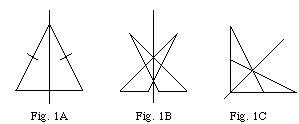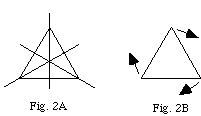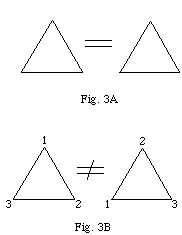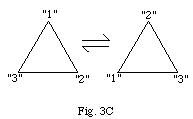www.integralscience.org


Symmetry n. 1. (beauty resulting from) right proportion between the parts of the body or any whole, balance, congruity, harmony. 2. such structure as allows of an object's being divided by a point or line or plane or radiating lines or planes into two or more parts exactly the same in size and shape and similar in position relatively to the dividing point etc., repetition of exactly similar parts facing each other or a centre; [f Gk. summetria : sum like + metron measure.] [14]
We will show in this essay how the above definition of symmetry may be generalized to a universal principle. Far from being limited to art and geometry, the essence of symmetry pervades the world at every level. Just as the artist mirrors the world and reveals its symmetrical structure, so does the mathematician, physicist, and religious philosopher. Symmetry is the archetypal key that unlocks the true nature of the world.
Let us begin our investigation of symmetry with a simple example. Consider the isosceles triangle in figure 1A. Since the vertical line bisects the triangle into two equal halves, it is an axis of symmetry. This is called a reflection symmetry since an imagined reflection along this axis leaves the triangle unchanged. Any other axis does not have this property. In fact, because this triangle has two equal sides, there is exactly one reflection symmetry. Figures 1B and 1C show triangles with no reflection symmetry.

Consider next an equilateral triangle. This triangle has three reflection symmetries, indicated by the three symmetry axes drawn in figure 2A. Upon reflection through any of these three axes the triangle remains the same. Choose any other axis, however, and the triangle will end up different. Figure 2B shows us that this triangle also has a rotational symmetry. When we rotate the triangle around the point at its center by 120 degrees or 240 degrees, it is not changed. It should be clear that a rotation by any other angle will leave the triangle different, as will rotation around any other point.

We can apply the same analysis to other figures as well, such as rectangles, squares, and circles. In each case, we will discover the characteristic symmetry properties of the figure. But in any case, the principle of symmetry is the same: change the figure so that it is left unchanged. This formulation of the idea behind symmetry suddenly reveals a paradox: we want to at once change the figure and leave it unchanged, create a difference and yet leave it the same. This paradox suggests that we take a closer look at symmetry.
Let us return to the triangle and attempt to isolate these opposing elements of difference and sameness. On the one hand, we recognize that symmetry without any distinction is impossible. For if the vertices are all absolutely identical, as shown in Fig. 3A, a symmetrical "change" does not really change anything at all and so there can be no symmetry. On the other hand, symmetry with absolute distinction is also impossible. For if the vertices are really distinct, as shown in Fig. 3B, then the change does not leave anything unchanged and hence there is no symmetry in this case either. Therefore, if difference is taken as real or unreal, symmetry can not exist.

The harmony of symmetry is revealed upon the recognition that distinction is neither real nor unreal. When we recognize it as imagined, the distinction becomes transparent to the underlying unity, and archetypal symmetry unfolds as the harmonious play of our imagined distinctions amidst the abiding unity. Thus, rather than mistaking symmetry for the extremes of unity (Fig. 3A) or diversity (Fig. 3B) we see it truly as the playful creation of diversity-in-unity (Fig. 3C).

From this simple example of the triangle, we have extracted an archetypal principle which applies in general: Whenever we find an underlying unity amidst apparent distinction, we have an instance of symmetry. But since all distinctions are only imagined, in truth there is always unity beneath apparent diversity, and thus symmetry is the true nature of every distinction. And since every object's existence (existence: literally, "to stand out") depends on its distinction from a background, symmetry reveals the true nature of all existence. As written in the Gospel According to John, "All things were made by it, and without it was not anything made that was made."[15] We have thus found the archetypal principle at the heart of all creation. As Plato put it,
We say that the one and many become identified by thought, and that now, as in time past, they run about together, in and out of every word which is uttered, and that this union of them. . .[is] an everlasting quality of thought itself, which never grows old. [16]
Discussing Plato's Parmenides, the Neoplatonist Proclus adds,
The cosmos is not a unity here and a plurality there, but a unity and a plurality at the same time throughout its whole being. . .and there is nothing you can take within it that is not both one and many. [17]
Franklin Merrell-Wolff described this principle of symmetry as Equilibrium, the Law which appears as subject-object relationship.[18] This symmetry of subject and object is revealed in the ultimate mystical insight: the recognition of the imaginary nature of the subject-object distinction, and hence the underlying identity of subject and object. Every object that comes into being is thus governed by this harmony of diversity-in-unity.
Just as we applied the principle of symmetry to the triangle, so we can apply this analysis of relationship to any object whatsoever, revealing the symmetry in all relationships, the unity amidst all distinctions. "By analogical transposition," Simone Weil tells us, "[these relationships] furnish the key to the whole of human knowledge. There is great profit in meditating indefinitely upon these relationships"[19]--which is just what the Buddhists have done for 2500 years. An analytic meditation on the true nature of distinction forms the foundation of their philosophic practice. Through meditation on the symmetry of all objects we follow the Middle Way between the extremes of real and unreal. This is what you must do, Plato tells us in Parmenides, "if you would train yourself perfectly and see the real truth."[20]
Let us take this sagely advice and apply this analysis to objects other than the triangle. Consider these words before you right now. They appear as objects distinct from you. Now let us investigate the nature of this distinction. Suppose there is a real distinction between you and these words. Then since you and the words are absolutely distinct and independent of each other, there is no common basis for the two, and hence there can be no way for you and the words to relate. But this contradicts your present awareness of them: since you have an immediate apprehension of these words right now, they cannot possibly be completely distinct from you. On the other hand, suppose that the distinction is absolutely unreal, that there is no distinction whatsoever between you and these words. This also contradicts your awareness of them right now, for your awareness of these words is made possible by the fact that there is distinction between you and them: with no distinction whatsoever, there would be no words "out there" to observe at all. Therefore these words are neither absolutely distinct nor absolutely non-distinct from you.
This analysis passes between the extremes, negating the exclusive truth of both absolute distinction and absolute non-distinction. Without making any positive assertions, it shows us our error simply by refuting the two extreme views on their own grounds. Thus the analysis frees us (analysis: literally, to loosen up, to free) from our clinging by revealing the contradictions inherent in holding exclusively to one extreme or the other.
In particular situations in our lives, we may find ourselves clinging repeatedly to an extreme. In order to free us from this extreme, we apply the half of the analysis which refutes it. For example, to develop compassion toward objects of aversion, we apply the half which shows the error of absolute distinction. On the other hand, to develop detachment from objects of identification, we apply the half which shows the error of absolute non-distinction. This is the practice of discrimination. In either case, the archetypal symmetry guides us along the razor's edge between extremes. And through the recognition of symmetry in our lives, the true nature of creation comes into focus until it is all seen to be the symmetrical play of imagined distinctions in utter unity.
In addition to revealing the true harmony of symmetry, this understanding of the imaginary nature of distinction also shows us how paradoxes and illusions arise. When we cling to the imaginary distinctions as real, the underlying unity is denied and the two distinct triangles cannot be related in any way. Conversely, when we cling to the imaginary distinctions as unreal, the difference is denied and there are then no distinct triangles to be related. In either case, there is ignorance of unity-in-diversity, and hence a denial of symmetry. But since symmetry is the true nature of all things, we end up in conflict with the world. And in this illusion lies the true origin of all our suffering. The very existence of this world apart from its source is Maya, an illusion which breaks symmetry, or ruptures equilibrium. As Simone Weil writes,
The energy which moves [the universe] is the principle of rupture of equilibrium. But, nevertheless, this becoming, composed of ruptures of equilibrium, is in reality an equilibrium because the ruptures of equilibrium compensate each other. [21]
Or, in the words of Franklin Merrell-Wolff,
An object exists as a tension. Although, in the ultimate sense, every tension is balanced by its opposite phase, so the equilibrium is never actually destroyed, yet consciousness, taken in a partial aspect, may comprehend only one phase, or may be only imperfectly conscious of the counterphase. For this partial aspect of consciousness, equilibrium does not exist. [22]
Thus, although in reality everything is blended in a harmonious whole, through Maya we mistake the imagined asymmetry as real, and equilibrium is apparently ruptured. This ignorance of symmetry, however, is only a trick of the imagination, an unconsciousness of the true nature of things. In reality, there is no breaking of symmetry. Not even in Maya is symmetry really broken. It is only imagined as really broken-- and that is Maya.
In Kashmir Shaivism, this process of apparent division which creates the world of Maya is not described as arbitrary or random. Rather, "its operation is marked by steps or stages, which follow one another as logical necessities--each successive step following inevitably from the one preceding it, as the deduction of a certain conclusion of a particularised kind follows inevitably. . .from certain premises of a general type."[23] In fact, G. Spencer-Brown has developed a mathematics of distinction which he compares to the "Levels of Eternity." Beginning with the Void, we create a single distinction, and out of this the whole calculus unfolds. As he describes these Laws of Form, "it's what would be if distinction could be."[24] The lawful order of the universe and its mathematical structure are thus seen as a direct consequence of the principle of symmetry, the nature of distinction.
We can now understand the creation of the world as an apparent symmetry- breaking which veils the underlying unity, restricting our view to the residue of a divided world. Conversely, through insight we rediscover the lost unity and return back to the recognition of the ultimate unity of all things in symmetry. In this world of apparent diversity, symmetry is both the link to our origin and the key to our destiny, connecting diversity with unity on every level.
Although physics deals with levels far removed from the original Void, we can still clearly see the symmetry-breaking process in its theories. From the universal laws, we descend down through progressive imposition of conditions which distinguish one situation from another and limit the laws accordingly. Beginning with the universal law of gravitation, for example, we impose constraints on the equation so that it describes our particular experimental conditions, such as an apple falling off a tree. The equation we thus deduce has only limited validity and is very different from the equation we might deduce for calculating the moon's orbit around the earth. Nevertheless, as Newton's genius was able to see, these two particular laws both derive from a single universal law of gravitation. So from the unity of a law we break the symmetry by imposing distinctions which limit its scope and validity. But if we recognize the universal law behind the derived particulars, the true symmetry is not lost.
While the practical application of these physical laws pretends to break symmetry, insights such as Newton's bind broken symmetry back together. This act is therefore religious in the deepest meaning of the word. (religion: literally, to bind back.) The whole of physics is thus a religious quest, for its purpose has always been to unify our understanding of nature, to rediscover the symmetry behind the apparently diverse phenomena. For example, when Maxwell discovered the equations which unified electricity and magnetism, separate laws pertaining to different parts of reality were united in a single, more universal law. Before Maxwell, the laws of electricity and magnetism were distinct. Now they are understood to be merely different manifestations of the same underlying electromagnetic laws. While electricity and magnetism still manifest as relatively distinct phenomena, today we recognize the identity behind these apparent differences, we see their symmetry. Thus, embedded in the mathematical representation of the world by physics we find the same archetypal principle as in the religious philosophies.
With our vision guided by symmetry, we have glimpsed the inner meaning of both scientific and religious thought, united under one archetypal symbol. But this principle of symmetry offers us much more than a vague glimpse of the unity behind science and religion. It provides a deep mathematical foundation which can show this unity explicitly. From the perspective offered by such a unification, science and religion as we know them today would be seen as particular and limited views of the world which may be derived from a more comprehensive vision of symmetry. Such a vision would combine the coherence of mathematics with the spirit of religion to give us a truly sacred science. In the visionary words of Simone Weil,
I believe that one identical thought is to be found--expressed very precisely and with only slight differences of modality-- in. . .Pythagoras, Plato, and the Greek Stoics. . .in the Upanishads, and the Bhagavad Gita; in the Chinese Taoist writings and. . .Buddhism. . .in the dogmas of the Christian faith and in the writings of the greatest Christian mystics. . .I believe that this thought is the truth, and that it today requires a modern and Western form of expression. That is to say, it should be expressed through the only approximately good thing we can call our own, namely science. This is all the less difficult because it is itself the origin of science. [25]